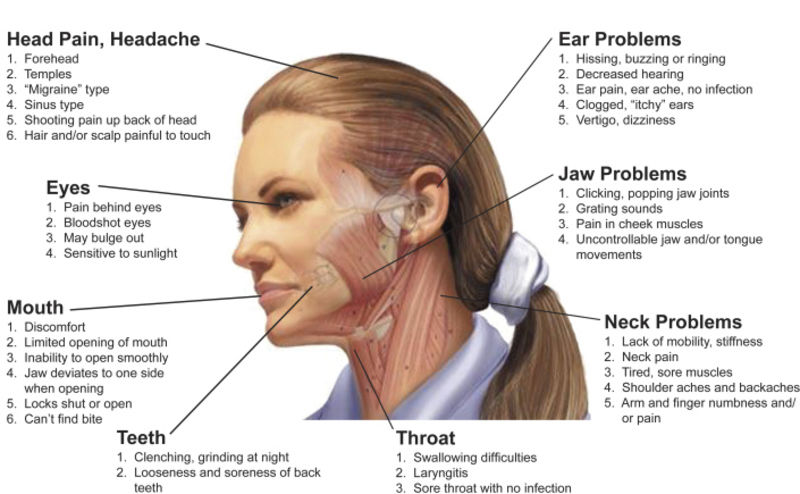My Bite AND My Spine?
Posture can be directly linked to the dental bite. Bite and TMJ from upper neck instability can cause headaches and migraines. When the posture is fixed by aligning the Atlas, then bite and TMJ can function in its most optimal state.
After years of working closely with a handful of dentists and TMJ specialists from the United States and Sydney, Australia; there’s one absolute trend that I see all too often. It is how the bite influence posture. This can then manifest problems such as headaches (including that of debilitating migraines), neck pain, hip pain, joint discomforts and even nerve pain. When a bite is “off”; it can stem from the temporal mandibular joint or it can be from the teeth. Whenever we bite down, there should be an even pressure throughout. If not, it is like having a pebble in your shoe making neutral walking practically impossible. Just as a pebble can shift the entire spine and posture; so can an abnormal bite. **see picture below. The lab rat on the right has a normal bite. As the bite shifts, so does the spine (picture left).
One of the biggest components to consider, however, is how the craniocervical junction plays into the bite. Which comes first? The upper neck misalignment that causes the cranial nerve (specifically CN 5 - trigeminal nerve that controls the muscles of mastication) or the TMJ displacement (or bite) that influence a misfire of the nerves that results in a distorted spine? It can actually be 50/50. Until we get one fixed, we will not be able to know its influence on the other. However, because the TMJ’s delicacy and changes to the bite is often permanent; the upper neck misalignment should be addressed first.
If you’re unsure if your health problems are an influence of the upper neck, contact us for a no obligation consultation.
These are no ordinary lab rats. What you can profoundly see is their shift in spinal posture as the bite is manipulated. How does this translate to our spine if we have dental malocclusion?
The Jaw – Spinal Cord Connection A Simple Check-up Can Make All the Difference in One’s Overall Health
Are you a pain victim of your dental appliance? Why checking the upper neck alignment is key before dental work.
The TMJ can lead to many painful issues. Often times, its caused by misalignment of the C1/Atlas.
More often when we think of mouth guard, its a common need for athletes. Its also used as a daily/nightly dental protection device. Are both needed? The simple answer is yes and yes, but it is important to understand its function. A mouth guard is a covering that is placed on the upper or lower teeth to protect the teeth from injury.
There are two parts to the jaw: the maxilla, which is the upper part of the skull, or the non-moveable part with teeth, and the mandible, or the moveable part with teeth. The connecting location is the TMJ. What holds these two parts together are the muscles and ligaments, which are all controlled by facial nerves that come from the brainstem and are connected to the first vertebrae (also called the atlas).
A more thorough dental version of a mouth guard, known as an appliance, will also protect the temporomandibular joint (TMJ), from injury during periods of grinding and or clenching.
Over-the-counter mouth guards are manufactured predominantly in two premade forms that protect the teeth, but a custom appliance made at a dental office also maintains the balance between the upper and lower jaw so that dysfunction or destruction do not occur. Its focus is to maintain a proper fluid motion of the TMJ to avoid injury or pain. Symptoms of imbalance include tooth pain, facial pain, headaches and neck pain. Using the latest technology, dentists have tools to identify many problems in the TMJ to make better diagnoses and appliances that prevent further damage to teeth and the TMJ joint.
The use of a dental appliance is important for the treatment of several jaw-related problems and appliances are also being used to address sleep apnea and snoring with great success. However, another aspect of a patient’s well-being is how the fit of that appliance affects the neurological flow of the entire body.
If the atlas is in alignment and the brainstem is firing its signals correctly, allowing the nerves to function as they should, an improperly set appliance will put pressure onto the nerves and actually be capable of taking the patient out of alignment at the atlas, causing the nerves to not fire correctly, and giving way to symptoms such as headaches, vertigo, TMJ issues and even low back pain.
A simple check can determine if the dental appliance is affecting the spinal alignment and nerve flow. If the nerves are not firing correctly, that is considered a misalignment. If it is determined that the mouth guard is causing a misalignment, having that appliance refit by a dentist that understands the jaw/ spinal cord connection and can work with your spinal health practitioner is key.
While mouth guards and dental appliances are valuable protective tools for a patient to continuously feel well, the combination of having a properly set dental appliance and staying in alignment is key.

